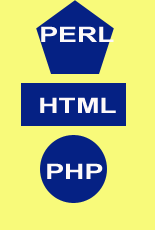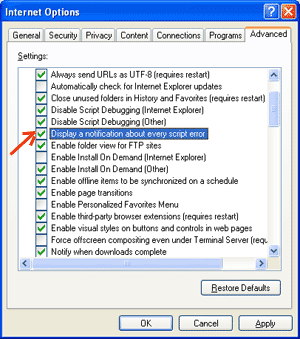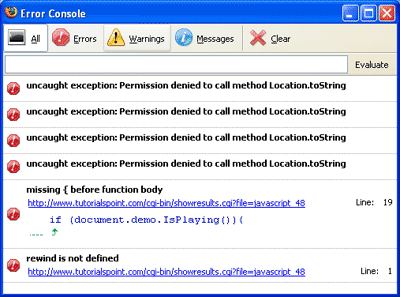There are three types of errors in programming: (a) Syntax Errors and (b) Runtime Errors (c) Logical Errors:
Syntax errors:
Syntax errors, also called parsing errors, occur at compile time for
traditional programming languages and at interpret time for JavaScript.
For example, the following line causes a syntax error because it is missing a closing parenthesis:
<script type="text/javascript">
<!--
window.print(;
//-->
</script>
|
When a syntax error occurs in JavaScript, only the code contained
within the same thread as the syntax error is affected and code in other
threads gets executed assuming nothing in them depends on the code
containing the error.
Runtime errors:
Runtime errors, also called exceptions, occur during execution (after compilation/interpretation).
For example, the following line causes a run time error because here
syntax is correct but at run time it is trying to call a non existed
method:
<script type="text/javascript">
<!--
window.printme();
//-->
</script>
|
Exceptions also affect the thread in which they occur, allowing other JavaScript threads to continue normal execution.
Logical errors:
Logic errors can be the most difficult type of errors to track down.
These errors are not the result of a syntax or runtime error. Instead,
they occur when you make a mistake in the logic that drives your script
and you do not get the result you expected.
You can not catch those errors, because it depends on your business
requirement what type of logic you want to put in your program.
The try...catch...finally Statement:
The latest versions of JavaScript added exception handling capabilities. JavaScript implements the
try...catch...finally construct as well as the
throw operator to handle exceptions.
You can
catch programmer-generated and
runtime exceptions, but you cannot
catch JavaScript syntax errors.
Here is the
try...catch...finally block syntax:
<script type="text/javascript">
<!--
try {
// Code to run
[break;]
} catch ( e ) {
// Code to run if an exception occurs
[break;]
}[ finally {
// Code that is always executed regardless of
// an exception occurring
}]
//-->
</script>
|
The
try block must be followed by either exactly one
catch block or one
finally block (or one of both). When an exception occurs in the
try block, the exception is placed in
e and the
catch block is executed. The optional
finally block executes unconditionally after try/catch.
Examples:
Here is one example where we are trying to call a non existing
function this is causing an exception raise. Let us see how it behaves
without with
try...catch:
<html>
<head>
<script type="text/javascript">
<!--
function myFunc()
{
var a = 100;
alert("Value of variable a is : " + a );
}
//-->
</script>
</head>
<body>
<p>Click the following to see the result:</p>
<form>
<input type="button" value="Click Me" onclick="myFunc();" />
</form>
</body>
</html>
|
Now let us try to catch this exception using
try...catch and display a user friendly message. You can also suppress this message, if you want to hide this error from a user.
<html>
<head>
<script type="text/javascript">
<!--
function myFunc()
{
var a = 100;
try {
alert("Value of variable a is : " + a );
} catch ( e ) {
alert("Error: " + e.description );
}
}
//-->
</script>
</head>
<body>
<p>Click the following to see the result:</p>
<form>
<input type="button" value="Click Me" onclick="myFunc();" />
</form>
</body>
</html>
|
You can use
finally block which will always execute unconditionally after try/catch. Here is an example:
<html>
<head>
<script type="text/javascript">
<!--
function myFunc()
{
var a = 100;
try {
alert("Value of variable a is : " + a );
}catch ( e ) {
alert("Error: " + e.description );
}finally {
alert("Finally block will always execute!" );
}
}
//-->
</script>
</head>
<body>
<p>Click the following to see the result:</p>
<form>
<input type="button" value="Click Me" onclick="myFunc();" />
</form>
</body>
</html>
|
The throw Statement:
You can use
throw statement to raise your built-in exceptions
or your customized exceptions. Later these exceptions can be captured
and you can take an appropriate action.
Following is the example showing usage of
throw statement.
<html>
<head>
<script type="text/javascript">
<!--
function myFunc()
{
var a = 100;
var b = 0;
try{
if ( b == 0 ){
throw( "Divide by zero error." );
}else{
var c = a / b;
}
}catch ( e ) {
alert("Error: " + e );
}
}
//-->
</script>
</head>
<body>
<p>Click the following to see the result:</p>
<form>
<input type="button" value="Click Me" onclick="myFunc();" />
</form>
</body>
</html>
|
You can raise an exception in one function using a string, integer,
Boolean or an object and then you can capture that exception either in
the same function as we did above, or in other function using
try...catch block.
The onerror() Method
The
onerror event handler was the first feature to facilitate error handling for JavaScript. The
error
event is fired on the window object whenever an exception occurs on the page. Example:
<html>
<head>
<script type="text/javascript">
<!--
window.onerror = function () {
alert("An error occurred.");
}
//-->
</script>
</head>
<body>
<p>Click the following to see the result:</p>
<form>
<input type="button" value="Click Me" onclick="myFunc();" />
</form>
</body>
</html>
|
The
onerror event handler provides three pieces of information to identify the exact nature of the error:
- Error message . The same message that the browser would display for the given error
- URL . The file in which the error occurred
- Line number . The line number in the given URL that caused the error
Here is the example to show how to extract this information
<html>
<head>
<script type="text/javascript">
<!--
window.onerror = function (msg, url, line) {
alert("Message : " + msg );
alert("url : " + url );
alert("Line number : " + line );
}
//-->
</script>
</head>
<body>
<p>Click the following to see the result:</p>
<form>
<input type="button" value="Click Me" onclick="myFunc();" />
</form>
</body>
</html>
|
You can display extracted information in whatever way you think it is better.
You can use
onerror method to show an error message in case there is any problem in loading an image as follows:
<img src="myimage.gif"
onerror="alert('An error occurred loading the image.')" />
|
You can use
onerror with many HTML tags to display appropriate messages in case of errors.


